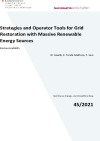Strategies and Operator Tools for Grid Restoration with Massive Renewable Energy Sources (RestoreGrid4RES)
Short Description
The growing contribution of renewable energies and the liberalisation process in electricity markets result in higher system stresses in terms of increasing system loadings and fluctuations. Combined with a delay of grid enhancements this results in an increasing risk of wide-area blackouts and a threat for successful grid restoration. This project investigated new grid restoration strategies to ensure a fast, coordinated and stable system restoration. In particular, on the one hand, it gives recommendations whether and how renewable generators shall contribute to the restoration process and, on the other hand, it identifies technical requirements that must be met observing the fact that the vast majority of renewable generation is connected to the distribution systems without direct control by the transmission system operators (TSO). To support the operators during this difficult procedure, a demonstration tool has been developed which shall guide the operators through the restoration process and give helpful information about possible next steps and their consequences.
RestoreGrid4RES faces the future renewable based generation structure within the transformation to a renewable and ecological power supply. Besides coping with a high share of renewable energies in normal grid operation, grid operation in emergency situations has to deal with this progression as well. In the unlikely event of a system-wide blackout, there have to be restoration strategies available which define how to restore the electricity system. This determined the aim of the project which is to ensure a fast but secure grid restoration after a system wide blackout in networks with high renewable energy generation.
Therefore, two main targets had to be achieved. First, by taking into account the modified cold load pick-up behaviour of networks including distributed generation, new grid restoration strategies have been developed to answer the question how grid restoration can proceed without interference by distributed renewable energy technologies. Moreover, it has been examined how renewable energy technologies may be actively used in the restoration process and what ancillary services or requirements they have to fulfil. Second, because of the need for new, trustworthy, robust and secure operator tools, an innovative restoration tool has been developed to guide the operators during grid restoration and to provide information about possible next steps and their consequences.
The Austrian partners played an important role in this project and have been involved in all work packages. Specifically, they have worked on following topics:
- As a first step, a review of current practices for a system restoration process has been conducted – with consideration of the legal framework and technical requirements. Thereby, also limitations of current practices have been identified - based on the vast experience of Austrian distributed system operators involved in the project.
- Steady state models of renewable energy technologies have been developed that allow for analysing the influence of renewable generation on grid restoration. Here, the focus of Austrian project partners was on models of small hydro generation typically in place in Austria, but also leveraging on knowledge about other renewable generation like photovoltaic and wind power plus storage and load models.
- New grid restoration strategies, in particular top-down, bottom-up or a combination of both approaches have been developed under consideration of lessons learned from Austrian stakeholders and project partners. In this context, by use of the previously developed models, the influence of renewable energy technologies as well as their possible proactive use has been examined. Derived strategies have been optimized based on quantification of economic costs and social welfare impacts.
- Finally, based on previous outcomes, recommendations and a roadmap for migration towards the proposed system restoration plan have been derived, which can be used by other Austrian system operators as well.
The developed restoration strategies with specific consideration of possibly active use of renewable and distributed generation result in recommendations on grid codes for emergency and restoration with respect to the ancillary services that these generators have to provide to successfully contribute in the overall system restoration process. While many smart grid projects focus on small smart grids (Microgrids), this project takes the whole Central European transmission system, of which the Austrian system is an integrative part, into account and thus gains a high scaling up-potential. The project provided a transparent overview of current grid restoration approaches. Thereby, it enables an assessment of the suitability of these approaches in the changing environment by increased installation of distributed energy resources. Thus, it allows a gap analysis and identification of necessary steps for Austrian system operators to adapt these approaches under new system conditions.
Publications
Strategies and Operator Tools for Grid Restoration with Massive Renewable Energy Sources (RestoreGrid4RES)

RestoreGrid4RES behandelt die zukünftige Erzeugungsstruktur auf Basis erneuerbarer Einspeiser im Zuge der Transformation auf eine erneuerbare und ökologische Stromversorgung. Das Projekt wurde im Rahmen der „Joint Programming Platform Smart Energy Systems“ (JPP SES) durchgeführt.
Series
45/2021
W. Gawlik, E. Torabi-Makhsos, Y. Guo
Publisher: BMK
English, 45 Seiten
Publication Downloads
Project Partners
Univ.Prof. Dr.-Ing. Wolfgang Gawlik, Dipl.-Ing. Elmira Torabi-Makhsos BSc, Dr.techn. Yi Guo, MEng.
Technische Universität Wien
